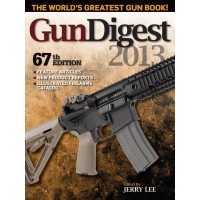Expand Your History Horizons
 The 1911 pistol model debuted just 20 years after the Krag went into service. It, too, changed the course of history. Enter your e-mail for a free Gun Digest download on the 1911. You'll also receive informative e-newsletters from Gun Digest and our marketing partners.
The 1911 pistol model debuted just 20 years after the Krag went into service. It, too, changed the course of history. Enter your e-mail for a free Gun Digest download on the 1911. You'll also receive informative e-newsletters from Gun Digest and our marketing partners.
[form id=”148401″]

The Krag-Jorgensen .30-40 is a historically significant rifle in that it transitioned the U.S. military from black powder to smokeless. It started looking at it in 1878, a scant two years after the defeat of General George Custer at Little Bighorn. By 1892, the Krag had officially been adopted by modern militaries and put into production.
In The Last Krag, a feature article appearing in Gun Digest 2013, John Malloy looks at the final variant of this important military gun, the NRA-DCM 22-inch barreled carbine.
But if you’re not familiar with the Krag-Jorgensen, here are 5 interesting facts that make it a no-brainer for the military gun collector.
First High-Velocity Small-Bore
As Malloy points out, “The Krag-Jorgensen rifle, often simply called the ‘Krag,' had an interesting place in our nation’s history,” he writes.
“It was the first U.S. high-velocity smallbore rifle … The cartridge was an American design. The rimmed, bottleneck cartridge case was a bit over 2¼ inches long. It used a .30-caliber 220-grain round-nose jacketed bullet in its ½-inch-long case neck. Forty grains of a new smokeless powder pushed the bullet to a velocity of about 2,000 fps. It was known variously as the .30 Government, .30 Army, .30 USA, or, more commonly later, as the .30-40 Krag. It was a good cartridge, one that would stand the test of time. It proved effective in military use and became a favorite of American big-game hunters.”
First Smokeless U.S. Military Rifle
“[The Krag] was also the first American smokeless powder military magazine rifle,” he notes. “European countries had been rapidly converting from blackpowder big-bores to smallbore smokeless powder military rifles, since 1886. In that year, the introduction of the 8mm French Lebel was shaking the military world.”
Since the U.S. was still hung up on the blackpowder .45-70 single-shot Trapdoor Springfield — while the French, Germans and Russians were developing high-velocity repeaters — “U.S. military planners realized they must modernize the issued rifle of the soldier, and so they did, adopting a new, high-velocity .30-caliber cartridge and a fast-operating repeating rifle.”

Unique Mag Arrangement
The Krag’s mag was really something to write home about:
“This new bolt-action rifle had a unique magazine. The cartridges were fed in from the right, passed horizontally in a passageway under the bolt, and came up on the left side of the receiver. At that point, the bolt could push a cartridge forward into the chamber. To insert the cartridges into the magazine, a special hinged mechanism on the right side was opened, and cartridges could be dropped into the cavity of the magazine. When the mechanism was closed, a spring-loaded follower arrangement pushed the cartridges into line and fed them across to the left, then up into the path of the bolt.”
Silky-Smooth Action
“The design of the bolt and its locking system, while not the strongest, made the Krag one of the smoothest bolt-action rifles ever produced — some would say the smoothest,” wrote Malloy. “The Krag bolt has only one actual locking lug, but it has a long guide bar on the bolt that contributes to its glass-smooth operation.”
Roosevelt’s Rough Riders
“[T]he Spanish-American War was a war waged over Cuba. Cuba meant San Juan Hill, and San Juan Hill meant the Rough Riders and their Krags; of course, it was not that simple, but the Krags, both the carbines in the hands of Roosevelt’s Rough Riders and the long rifles in the hands of the regular Army, performed well.”
 This excerpt is from the new Gun Digest 2013 annual book. To learn more about the Krag and many more guns than you can shake a stick at, Click Here to Get Your Copy.
This excerpt is from the new Gun Digest 2013 annual book. To learn more about the Krag and many more guns than you can shake a stick at, Click Here to Get Your Copy.
You'll Love This If:
- You're a gun collector interested in firearm history
- You want gun reviews of the latest rifles, shotguns, handguns, muzzleloaders and airguns
- You enjoy reading about guns as much as you do buying, selling and shooting them
